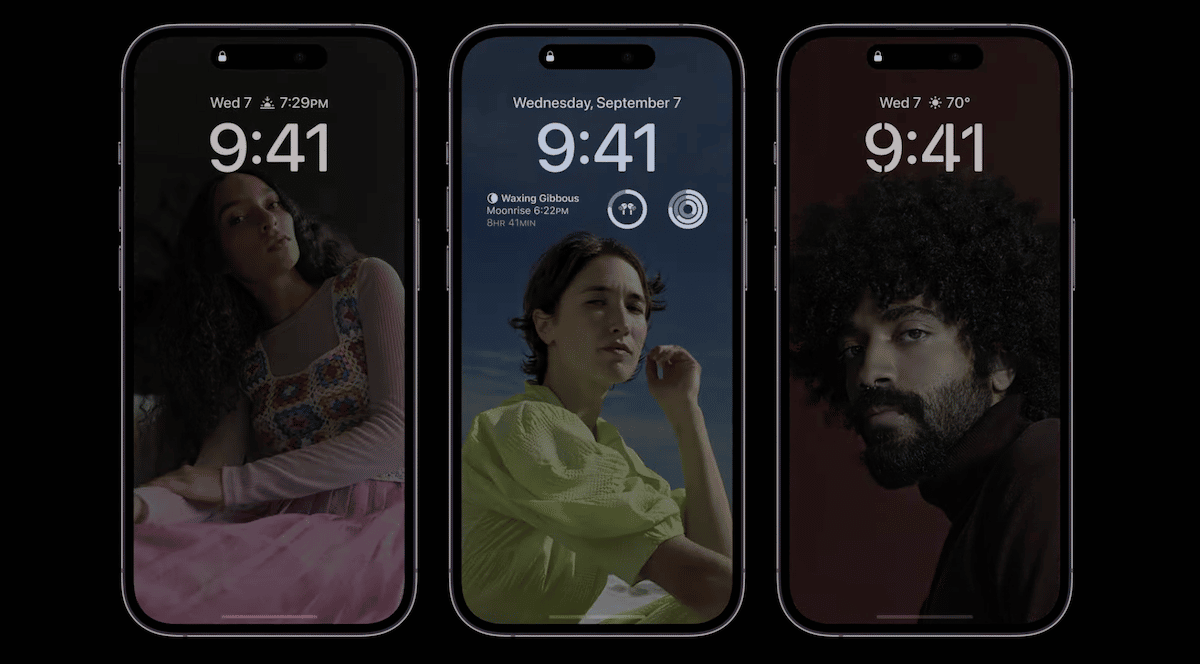Apple’s new iPhone 14 Pro line-up features an always-on display that shows the lock-screen widget, date and time, live activities, and wallpaper. Instead of date/time and notification icons on a black display, Apple has opted for a display that shows color, and only goes dark when faced down or in a pocket. Here is all you need to know about how this works and how Apple saves battery life despite the colorful always-on display.

iPhone 14 Pro always-on display
The always-on display in iPhone 14 Pro takes advantage of the following technologies:
- OLED display. OLED displays turn off pixels when black color is displayed on the screen, which makes them more efficient than other types of displays such as LED.
- LTPO (low-temperature polycrystalline oxide) support which allows the display to downclock refresh rate to as low as 1Hz while delivering exceptional battery life. This is the same technology that Apple has been using on Apple Watch since Series 5.
- Machine learning is used to ensure that skin tones in wallpapers remain intact even when the display is dimmed.
- New Display Engine in A16 Bionic chip which enables the 1Hz refresh rate, and always-on display, alongside other features.
One may ask – always-on displays have been in Windows Phones (RIP) and Android phones for ages, so what is different in Apple’s implementation that it took so long?
Here is what might be the reason. The combination of the aforementioned technologies allows the iPhone 14 to provide an always-on display experience that is not only extremely power-efficient but also avoids burn-out and shows visuals that match the lock-screen when it’s turned on. Apple has been doing this with Apple Watch and the battery life has not taken a major hit, even though turning it off always increases battery life further.
Apple’s battery estimates for iPhone 14 Pro mention the following, with Always-On display enabled:
iPhone 14 Pro
- Video playback: 23 hours
- Video playback (streamed): 20 hours
- Audio playback: 75 hours
iPhone 14 Pro Max
- Video playback: 29 hours
- Video playback (streamed): 25 hours
- Audio playback: 95 hours
However, Apple notes on its battery information page that the audio playback time decreases when the Always-On display is visible, which confirms that there is an impact on the battery life, despite the power optimizations.
iPhone 14 Pro and iPhone 14 Pro Max were tested with Always-On display enabled but with the display not visible; audio playback time will decrease when Always-On display is visible, compared to playback time when the display is face down on a surface or in a pocket or bag.
We will have to wait for reviews and real-world testing to see how much the difference is in battery life, however, during normal use, the impact should be minimal as the display will dim when in pocket or face down. Battery-conscious users can also disable the always-on display, for additional savings. It may also be possible to save additional battery life by using a completely black wallpaper, which would allow the OLED display to consume less power since it will turn off most of the pixels that will display the black color.
It has also been shared online that iPhone 14 Pro uses proximity data from a paried Apple Watch, and turns off the always-on display when the user leaves a room. This also helps with additional battery savings.
Read more:
- iPhone 14 and AirPods Pro 2 support Bluetooth 5.3, but LE Audio support not confirmed
- All iPhone 14 models feature 6GB of RAM
- iPhone 14 vs. iPhone 13: battery life comparison
- AppleCare+ for iPhone 14 Pro and iPhone 14 Pro Max subscription fees
- AppleCare+ for iPhone 14 and iPhone 14 Plus subscription fees
- Apple introduces two new finishes for iPhone 14 Pro and Pro Max: Space Black and Deep Purple
- iPhone 14 series widens the gap between standard and Pro models
- Here is how the new iPhone 14 Pro “magical” Dynamic Island works
- iPhone 14 Pro’s 48MP camera system enables improved low-light performance, new Action mode, and much more
- iPhone 14 lineup offers Emergency SOS via satellite, eliminating the need for cellular or Wi-Fi
- iPhone 14 lineup ditches the SIM card for eSIM technology in the U.S.
- iPhone 14 Pro tidbits: thickness, brighter display, autofocus, 4K Cinematic mode, Emergency SOS via satellite cost and more
- iPhone 14 Pro benchmarks: A16 is up to 15% faster than iPhone 13 Pro